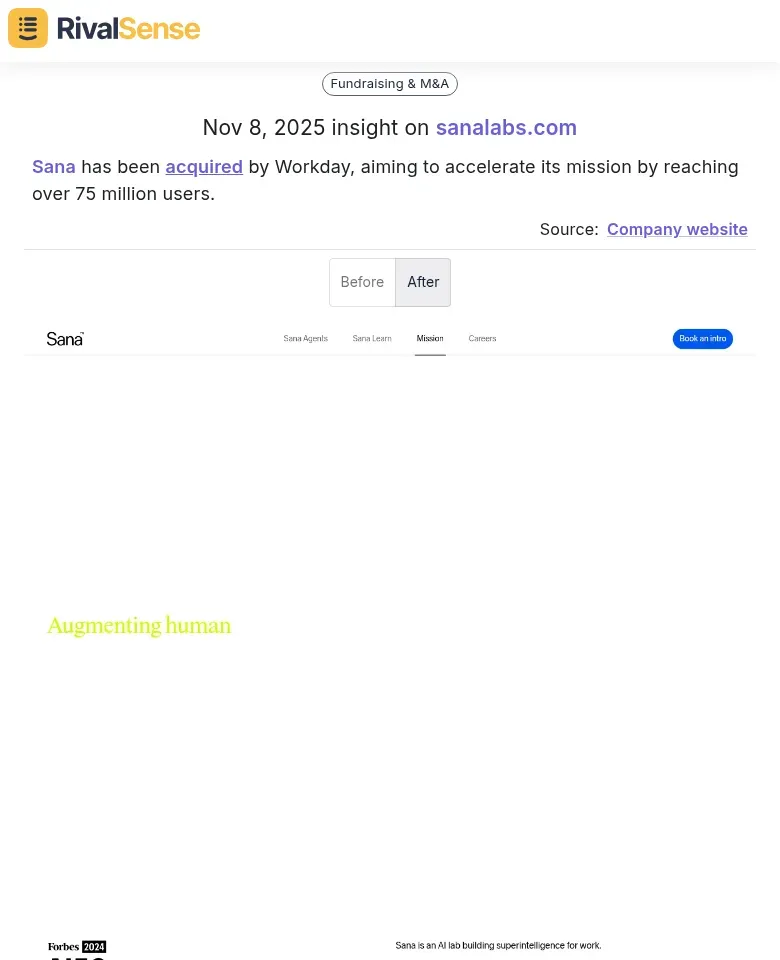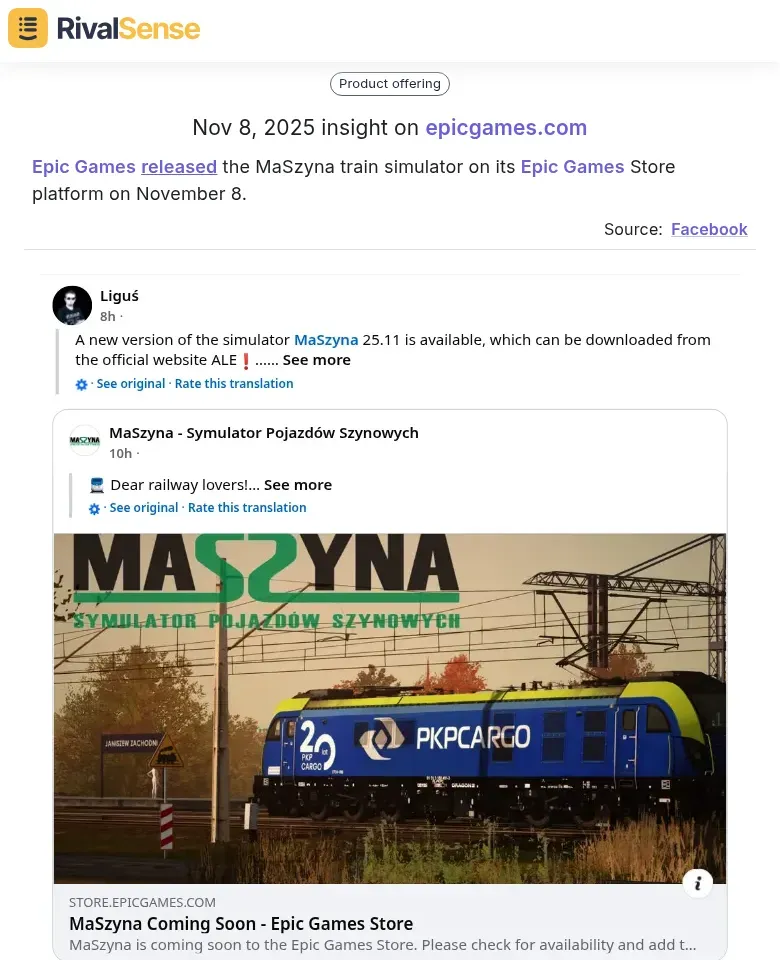Competitor Customer Churn Analysis: How to Gain Competitive Advantage by Understanding Why Customers Leave
November 11, 2025
Strategy & Insights
CONTENTS
- What is competitor customer churn analysis?
- Why analyzing competitor churn gives you strategic advantage
- How to measure and analyze competitor churn patterns
- 5-step framework for conducting competitor churn analysis
- Practical checklist: Turning competitor churn insights into action
- How to proactively reduce your own churn using competitor intelligence
- Conclusion: Building a churn-resistant business
Ever wonder why your customers are switching to competitors? Or why some competitors seem to retain customers better than others? You're not alone. Customer churn is one of the most critical metrics for B2B companies, but what if you could understand not just your own churn, but your competitors' churn patterns too?
In this comprehensive guide, you'll discover:
- How to analyze competitor customer churn without access to their internal data
- Practical frameworks for identifying why customers leave competing solutions
- Actionable strategies to turn competitor churn insights into your retention advantage
- Real-world examples of companies that transformed their retention by understanding competitor weaknesses
WHAT IS COMPETITOR CUSTOMER CHURN ANALYSIS?
Competitor customer churn analysis is the process of investigating why customers are leaving your competitors' products and what patterns emerge from their attrition. While traditional churn analysis focuses on your own business, competitor churn analysis gives you external intelligence about market trends, customer preferences, and competitor weaknesses. This approach allows you to see the bigger picture beyond your own metrics.
Practical Example: Imagine you notice a competitor's customers consistently churning after 6 months. Through analysis, you discover they struggle with enterprise-level feature gaps. This becomes your opportunity to strengthen those specific features and target their dissatisfied customers.
WHY ANALYZING COMPETITOR CHURN GIVES YOU STRATEGIC ADVANTAGE
IDENTIFY MARKET GAPS AND OPPORTUNITIES
When you understand why customers leave competitors, you uncover unmet market needs. These insights help you anticipate where your product can fill voids and attract new users. By analyzing churn triggers, you can proactively address industry pain points.
- Develop features that address common pain points
- Position your product as the solution to industry-wide problems
- Create targeted messaging that resonates with dissatisfied customers
Tip: Track competitor product announcements and updates. If they're frequently launching new features in a specific area, it might indicate they're trying to address high churn in that domain.
PREDICT INDUSTRY TRENDS BEFORE THEY HAPPEN
Customer churn patterns across multiple competitors reveal broader market shifts. If several competitors are experiencing churn around pricing, it might signal market resistance to current pricing models. Staying ahead of these trends allows you to adapt your strategy early.
Practical Insight: Use tools like RivalSense to monitor competitor pricing changes, feature launches, and customer feedback across 80+ sources. This gives you real-time intelligence about how competitors are responding to their own churn challenges.
Example: When Kilo Health rebranded to Kilo™, it positioned itself as a co-founding partner for ventures in health, wellness, beauty, and travel. This type of rebranding insight is valuable because it can indicate a strategic shift to address customer churn or attract new market segments, helping you anticipate industry trends and adjust your positioning accordingly.

IMPROVE YOUR CUSTOMER ACQUISITION STRATEGY
Understanding competitor churn helps you refine how you attract and convert new customers. By knowing why others fail, you can highlight your strengths and create compelling reasons for switches.
- Target customers who are likely to churn from competing solutions
- Develop compelling value propositions that address competitor weaknesses
- Create migration paths that make switching to your solution seamless
HOW TO MEASURE AND ANALYZE COMPETITOR CHURN PATTERNS
CALCULATE ESTIMATED COMPETITOR CHURN RATES
While you can't access competitors' exact churn data, you can estimate it using indirect indicators. This method provides a reliable approximation to guide your decisions.
-
Customer Count Analysis: Track competitor customer numbers over time through:
- LinkedIn employee count growth (correlates with customer growth)
- Customer case study publication frequency
- Review platform customer volume changes
-
Revenue Indicators: Monitor signals like:
- Pricing changes (often response to churn pressure)
- Discount frequency and intensity
- Customer success hiring patterns
Checklist: Competitor Churn Indicators to Monitor
- [ ] Sudden pricing model changes
- [ ] Increased customer success hiring
- [ ] Frequent feature launches in specific areas
- [ ] Changes in customer review sentiment
- [ ] Shifts in marketing messaging emphasis
- [ ] Partnership announcements (often to fill feature gaps)
ANALYZE COMPETITOR CUSTOMER FEEDBACK CHANNELS
Gather qualitative data from public sources to understand the voice of the customer. This feedback reveals underlying issues that quantitative data might miss.
- Review platforms (G2, Capterra, Trustpilot)
- Social media mentions and complaints
- Customer support forums
- Case study analysis (what problems are they solving?)
Practical Step: Create a competitor feedback dashboard that aggregates customer complaints, feature requests, and satisfaction scores across all public channels.
Example: The acquisition of Sana by Workday aims to accelerate its mission by reaching over 75 million users. Such acquisition insights are valuable as they can reveal how competitors are expanding their reach or capabilities to reduce churn and strengthen their market position, giving you clues about strategic moves to watch.

5-STEP FRAMEWORK FOR CONDUCTING COMPETITOR CHURN ANALYSIS
STEP 1: IDENTIFY COMPETITOR CHURN TRIGGERS
Monitor competitor communications for churn indicators to spot early warning signs. This step helps you understand what actions competitors are taking to retain users.
- Product update frequency and focus areas
- Customer success content themes
- Pricing structure changes
- Partnership announcements
Example: If a competitor suddenly launches extensive onboarding resources, they might be addressing high early-stage churn.
Insight: Epic Games released the MaSzyna train simulator on its Epic Games Store platform. Product launch insights like this are crucial because they show how competitors are introducing new content to engage users and potentially reduce churn by offering variety and novelty, highlighting areas where you might need to innovate.

STEP 2: ANALYZE COMPETITOR CUSTOMER JOURNEYS
Map out the typical customer experience with competitors to identify friction points. Understanding their journey helps you optimize yours to prevent similar issues.
- Onboarding process and documentation
- Feature adoption patterns
- Support response times and quality
- Upgrade/downgrade processes
Tip: Use tools that track competitor website changes, feature launches, and support documentation updates to understand how they're optimizing customer journeys.
STEP 3: SEGMENT COMPETITOR CUSTOMER BASE
Identify which customer segments experience highest churn to target your efforts effectively. Segmentation allows for more precise strategy development.
- By company size
- By industry vertical
- By use case
- By geographic region
Practical Advice: Create customer personas for each competitor and track which personas show highest dissatisfaction signals.
STEP 4: IDENTIFY PATTERNS IN COMPETITOR CUSTOMER COMPLAINTS
Analyze common themes in competitor customer feedback to uncover systemic issues. This step turns qualitative data into actionable insights.
- Feature gaps or limitations
- Pricing concerns
- Support quality issues
- Integration challenges
Actionable Insight: Use sentiment analysis on competitor reviews to quantify complaint frequency and severity.
STEP 5: CORRELATE COMPETITOR ACTIONS WITH CHURN SIGNALS
Track how competitor business decisions correlate with customer satisfaction to validate your hypotheses. This correlation helps you predict outcomes and plan accordingly.
- Product launches and customer response
- Pricing changes and review sentiment
- Management changes and customer confidence
- Event participation and market perception
PRACTICAL CHECKLIST: TURNING COMPETITOR CHURN INSIGHTS INTO ACTION
COMPETITOR INTELLIGENCE GATHERING
- [ ] Set up monitoring for competitor product updates and feature launches
- [ ] Track competitor pricing changes and customer responses
- [ ] Monitor competitor customer reviews and support forums
- [ ] Follow competitor leadership communications and event participation
- [ ] Analyze competitor partnership announcements and strategic moves
DATA ANALYSIS AND PATTERN IDENTIFICATION
- [ ] Identify common complaint themes across competitor customer bases
- [ ] Track competitor feature development priorities
- [ ] Monitor competitor customer success hiring and initiatives
- [ ] Analyze competitor marketing messaging shifts
- [ ] Correlate competitor business decisions with customer sentiment
STRATEGIC ACTION PLANNING
- [ ] Develop features that address competitor weaknesses
- [ ] Create targeted messaging for dissatisfied competitor customers
- [ ] Optimize onboarding to prevent common industry churn points
- [ ] Adjust pricing strategy based on competitor churn patterns
- [ ] Build partnerships to fill gaps identified in competitor offerings
HOW TO PROACTIVELY REDUCE YOUR OWN CHURN USING COMPETITOR INTELLIGENCE
CREATE TARGETED ONBOARDING THAT ADDRESSES INDUSTRY PAIN POINTS
Use competitor churn analysis to identify common onboarding failures in your industry and design your onboarding to specifically address these points. A tailored onboarding experience can significantly reduce early churn.
Example: If competitors struggle with enterprise feature adoption, create specialized enterprise onboarding that demonstrates value quickly.
DEVELOP FEATURES THAT SOLVE INDUSTRY-WIDE FRUSTRATIONS
Instead of guessing what features to build, use competitor churn patterns to prioritize development that addresses actual market needs. This data-driven approach ensures resources are spent on high-impact areas.
Practical Tip: When you notice multiple competitors struggling with the same feature gap, that's your opportunity to differentiate.
IMPLEMENT PROACTIVE CUSTOMER SUCCESS BASED ON INDUSTRY PATTERNS
Use competitor churn timing patterns to anticipate when your customers might experience similar challenges and intervene proactively. Early intervention can prevent churn before it happens.
Checklist: Proactive Churn Prevention
- [ ] Identify common churn timing patterns from competitor analysis
- [ ] Create intervention workflows for high-risk periods
- [ ] Develop educational content addressing industry pain points
- [ ] Implement health scoring based on competitor churn triggers
- [ ] Train customer success teams on industry-specific retention strategies
CONCLUSION: BUILDING A CHURN-RESISTANT BUSINESS
Competitor customer churn analysis transforms your retention strategy from reactive to proactive. By understanding why customers leave competing solutions, you can:
- Build features that address real market needs
- Create onboarding experiences that prevent common industry failures
- Develop targeted acquisition strategies for dissatisfied customers
- Anticipate market trends before they impact your business
- Build a truly churn-resistant organization
Remember: The goal isn't just to reduce your own churn, but to understand the entire market ecosystem. When you know why customers leave competitors, you can ensure they never have a reason to leave you.
Start implementing these strategies today and turn competitor weaknesses into your competitive advantage.
📚 Read more
👉 How to Track Competitor Podcasts for Market Dominance in Heavy Equipment Repair
👉 How RingCentral's AI Shift Reveals Your Next Growth Move
👉 Uncover Competitor Strategy Through Website Change Intelligence
👉 AI Data Labeling: Key Account Growth Strategies That Drive Revenue
👉 Competitor Employee Change Checklist: A Strategic Guide for Key Account Management
